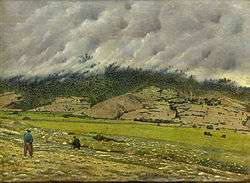Kelardasht
| Kelardasht كلاردشت | |
|---|---|
| City | |
 | |
 Kelardasht | |
| Coordinates: 36°31′00″N 51°10′00″E / 36.51667°N 51.16667°ECoordinates: 36°31′00″N 51°10′00″E / 36.51667°N 51.16667°E | |
| Country |
|
| Province | Mazandaran |
| County | Chalus |
| Bakhsh | Kelardasht |
| Population (2016 Census) | |
| • Total | 13,401 [1] |
| Time zone | UTC+3:30 (IRST) |
| • Summer (DST) | UTC+4:30 (IRDT) |


Kelardasht (Persian: كلاردشت, also Romanized as Kalārdasht)[2] is a city and capital of Kelardasht District, in Chalus County, Mazandaran Province, Iran. At the 2006 census, its population was 11,921, in 3,361 families.[3]
The city is composed of 5 districts (Hasankif, Lahoo, Kordichal, Valbal and Roudbarak). Hasankif has been the business district for many years and is currently also the political center.[4]
Originally a farming area, in recent years much of its land was sold in small lots to build numerous villas[5] which are occupied by summer visitors trying to escape the heat of Tehran and points further south.
Its attractions include Alamkooh Mountain (the second tallest peak in Iran (4850 m)), Abbasabad Road, Valasht lake and cooler climate. Picnicking and mountain climbing in the area surrounding RoudBarak are also popular, as well as in the Abbasabad Forest nearby.
The majority of the inhabitants speak Mazandarani language, but a few migrants speak Kurdish.[6]
See also
- Kelar Mound, Neolithic dwelling site in Kelardasht
- Roudbarak, Roudbarak located North of Kelardasht
References
- ↑ https://www.amar.org.ir/english
- ↑ Kelardasht can be found at GEOnet Names Server, at this link, by opening the Advanced Search box, entering "-3841000" in the "Unique Feature Id" form, and clicking on "Search Database".
- ↑ "Census of the Islamic Republic of Iran, 1385 (2006)". Islamic Republic of Iran. Archived from the original (Excel) on 2011-11-11.
- ↑ Saeidian, Abdolhossein. Know the Cities of Iran [Persian title is Shenakht-e Sharha-ye Iran]. Alam va Zendagi, Tehran 2000. Second printing 2004. Pages 705-708. [Text is in Persian]
- ↑ Pur, Ali Malek. Kelardasht (geography, History & Culture). Tehran: Kar Afrinan, 1999.
- ↑ http://www.magiran.com/npview.asp?ID=1535663
External links
| Wikimedia Commons has media related to Kelardasht. |